Principles of Microeconomics - Semester 2 key terms
1/92
There's no tags or description
Looks like no tags are added yet.
Name | Mastery | Learn | Test | Matching | Spaced |
|---|
No study sessions yet.
93 Terms
Conditions for Price discrimination:
Sellers must be price makers
Must be able to influence market price / price-setting power
Buyers must be different and sellers must be able to identify
Market differentiation / distinguish consumers
Consumers must NOT be able to participate in arbitrage
Cannot - buy at low and sell to buyer who would have paid a high price
Characteristics of market structure:
Market structure: A structure that refers to characteristics of a market that may affect trades
Characteristics:
n. and size of sellers (firms)
Barriers to entry
Product differentiation
n. and size of buyers (individuals)
Assumption market = product market
Perfect competition:
Extreme on the competition spectrum, with unrealistic assumptions with few IRL examples
However, agricultural and financial markets are close.
Rules of perfect competition:
Rule 1: Marginal output rule | Rule 2: Shutdown |
MR = MC, prevent shut down | Shutdown if p < AC |
MR > MC, then P increases (^ = TR - TC) | SR: p < AVC 😟 |
LR: p < LRAC 😟 |
Assumptions of Perfect competition
Buyers = Price Takers
Complete information
Sellers = Price Takers
All firms have no market power
Free entry (L-R decision)
capital —> employ —> Q rises
Characteristics of perfect competition:
Many small sellers
Low B2E
Undifferentiated products
as output is a small fraction of total industry output
Firms do not actually compete with each other e.g. Essex and Somerset farmers
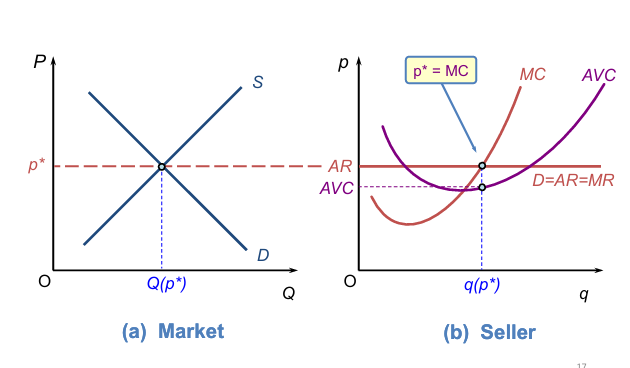
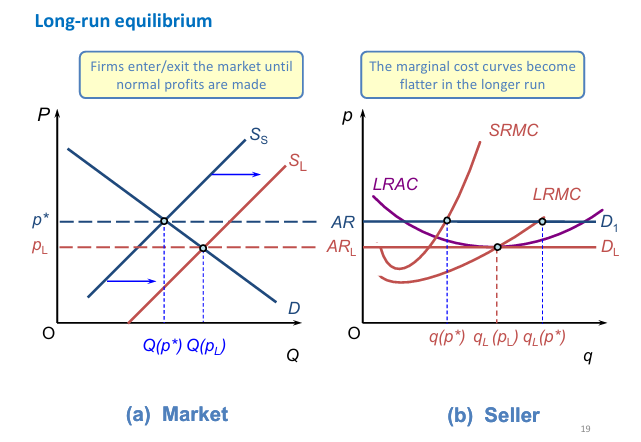
LR EQ of Perfect competition:
Occurs when firms earn zero profit at the break-even price
Change due to factor variability and low barriers to entry
Sellers and buyers produce or purchase as much as the other desires
TF, sellers make NP in the LR
Third condition - Incumbent sellers stay and potential sellers do not enter
No incentive to enter or leave the industry as they break even and can invest elsewhere
Assumptions of a Monopoly:
Buyers are PT and complete information
Monopolist = Price maker with price setting power
Seller sells more with lower price
Seller’s output choice does not trigger a reaction from competitors
Entry is BLOCKED; legal, structural or strategic B2E
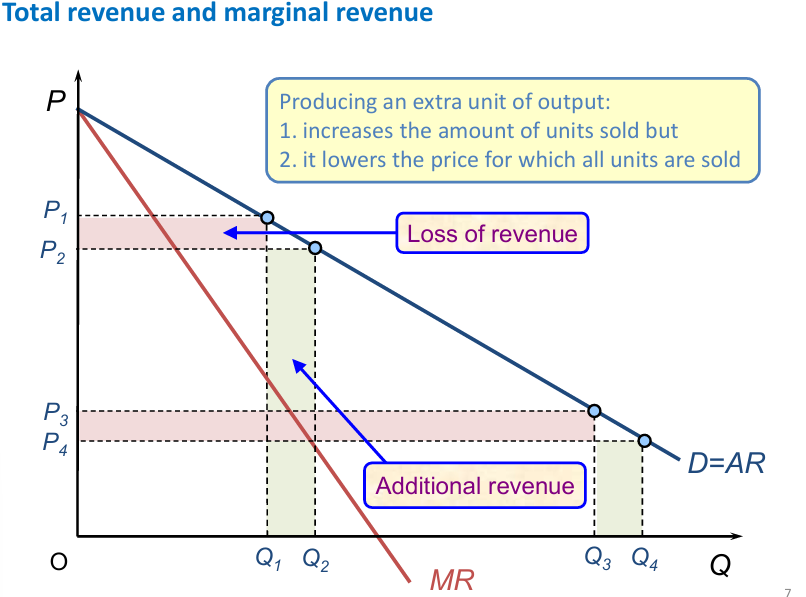
Monopoly market structure:
One large firm
High B2E and differentiated products
Opposite of PC which include many small firms, low B2E and undifferentiated product
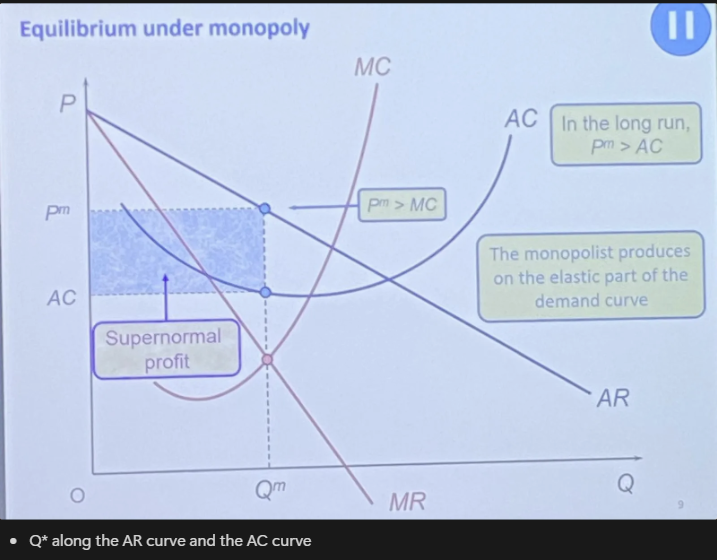
Monopoly EQ
Q* along the AR curve and the AC curve
Pm = monopolist price
SNP at Qm, MC through minimum of AC
Produces on the elastic part of the demand curve
Positive MR —> TR rises with extra Q unit, elasticity > 1
Negative MR —> TR falls with extra Q unit, 0 < e < 1
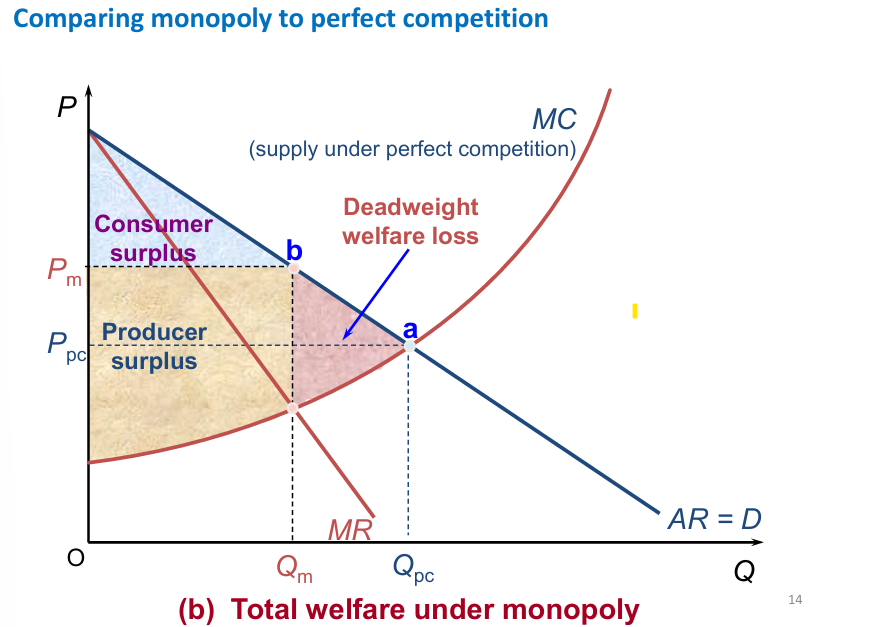
Monopoly vs perfect competition:
Monopoly is worse in terms of total welfare (PS + CS) than PC on the consumer
Consumer surplus: different between demand curve and the price (above P*)
Producer surplus: difference between price and supply curve (below P*)
Producer surplus has increased (compared to usual CS PS diagram),
Consumer surplus has decreased
DWL has arisen
Lower quantity and higher price
Total welfare has fallen compared to under PC
Monopoly inefficiency:
Monopolies are allocatively inefficient as consumer surplus is lower than perfect competition and there is no incentive to reduce price
This creates DWL
The firm does not maximise producer and consumer surpluses
First-degree price discrimination:
Sellers charge each buyer the max price the buyer is willing to pay
Another unit is sold at a lower price so TR increases but there is no marginal forthcoming decline of price level due to PD. MR = AR
TR = p = AR
e.g. Miss Rich is willing to pay £40 for the first unit and £20 for the second unit
would be charged both these prices for both these units
Unlikely in the real world, but an important foundation
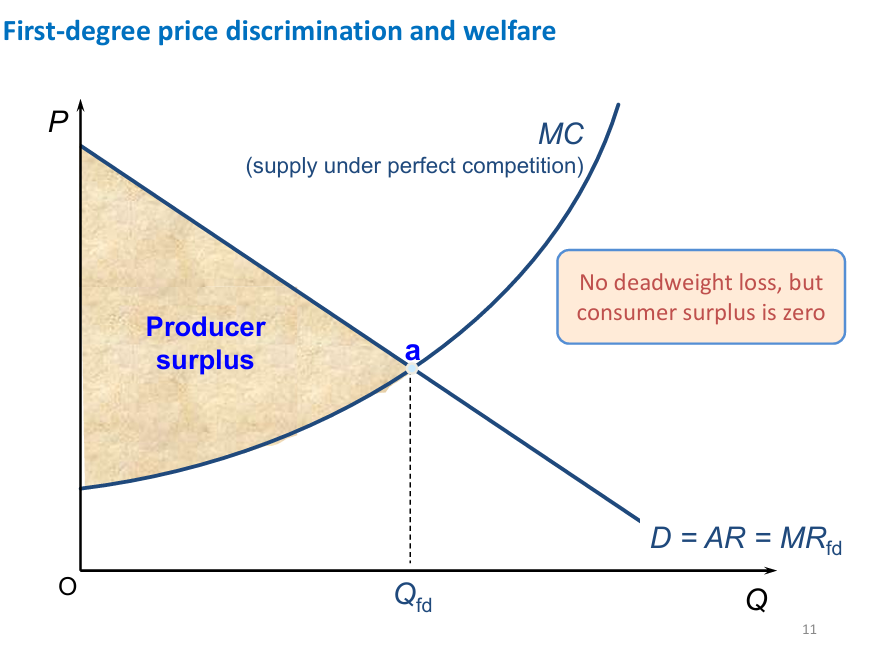
First-degree price discrimination and welfare diagram:
Produces at the same point of Perfect Competition
NO DWL or CS; this is because every consumer is charged at their max willingness to pay and thus reap no additional benefit
Monopolist changes different prices for each unit sold
Produces more than what it would if it couldn’t price discriminate
Third-degree price discrimination:
seller can identify groups of buyers and differ prices charged
Grouped by characteristics e.g. students / non-students
Grouped by location e.g. HIC vs LIC
Marginal costs increase in output
Must be able to identify markets, keep them separate and maintain different prices, whilst also preventing arbitrage
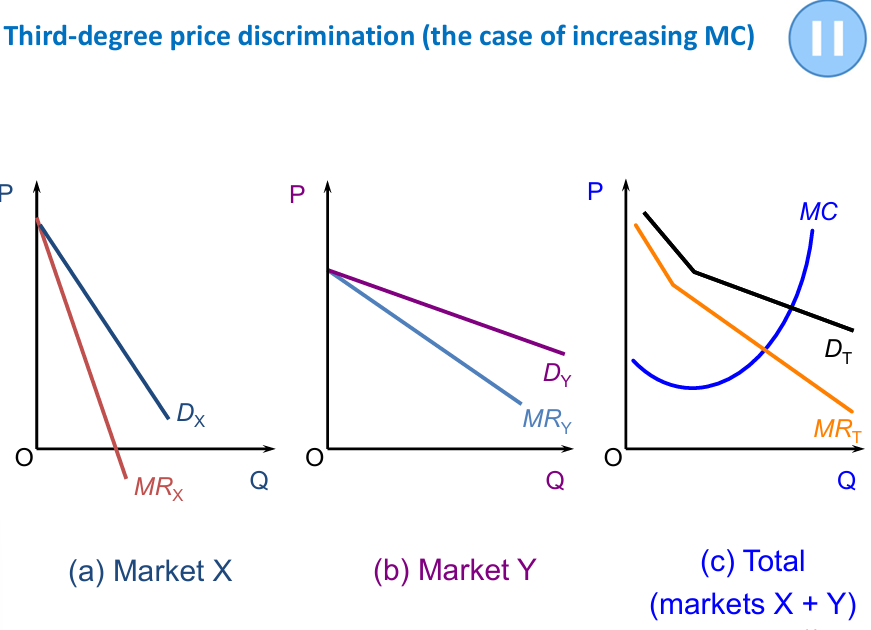
Third-degree price discrimination diagram:
Market X and Market Y differ depending on level of demand
Summing MRx and MRy gives the total market MR curve
intersecting with MC —> Pmax and draw line across, then connect to x axis
Market X - charged higher price with more inelastic demand
Market Y - charged lower price with more elastic demand
Total = Market X + Market Y
CS = positive, higher than first degree
DWL where prices > MC
price lies between two groups
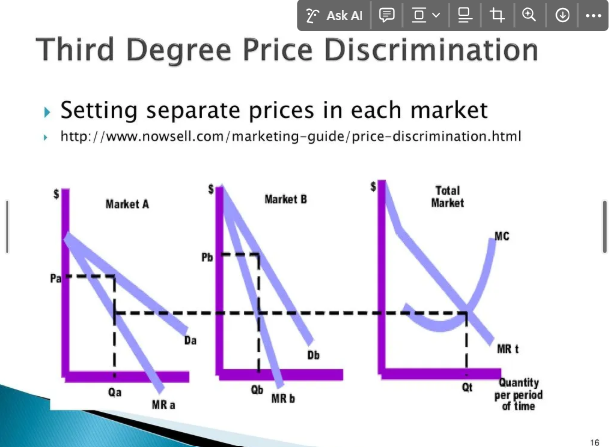
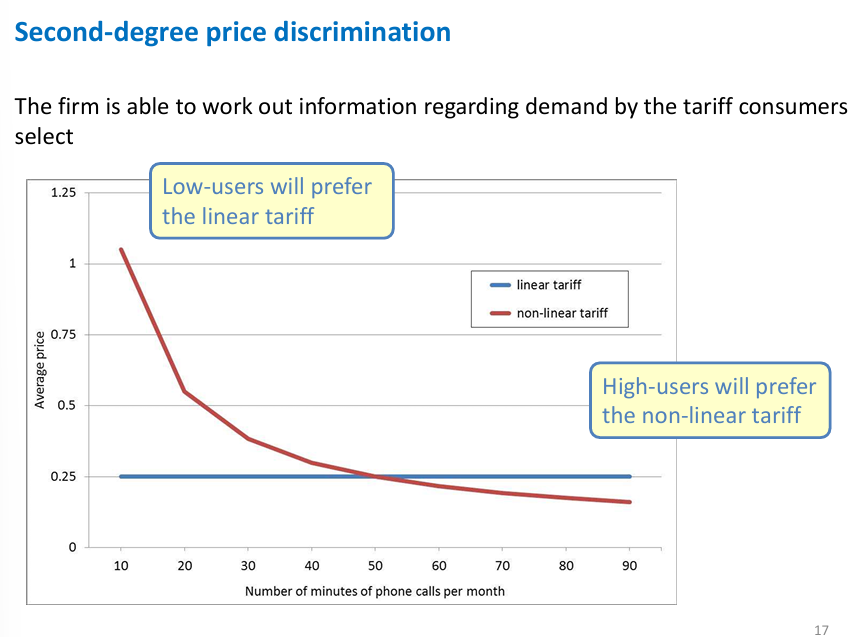
Second-degree price discrimination and linear / non-linear tariffs
A seller can use a menu of “non-linear tariffs” to get buyers to reveal preferences when they select their preferred tariff
Linear tariff: same price charged for every unit sold
25p per minute for phone calls
Non-linear tariff: average price per unit changes
£10 per month and 5p per minute
Characteristics of Monopolistic Competition:
many sellers in competition
price-setting power
Seller can raise price and not lose all its sales
low barriers to entry
differentiated products / imperfect substitutes
horizontal: same quality, diff tastes
vertical: quality differs, same tastes
Assumptions of Monopolistic Competition
buyers are price takers
complete information
Sellers are price makers
Sells more with lower price
Does not trigger a rival reaction if Q changes
Free entry - LR entry has no incurring costs; LR decision (FoP)
Pub example of symmetric sellers in Monopolistic competition:
Symmetric demand:
4000 people who go to 40 pubs
at market price, each pub would have 100 people
+10 pubs with constant pubs
Each pub would have 80 regulars (4000 / 50 pubs)
Incumbent lose 20 people to entrants
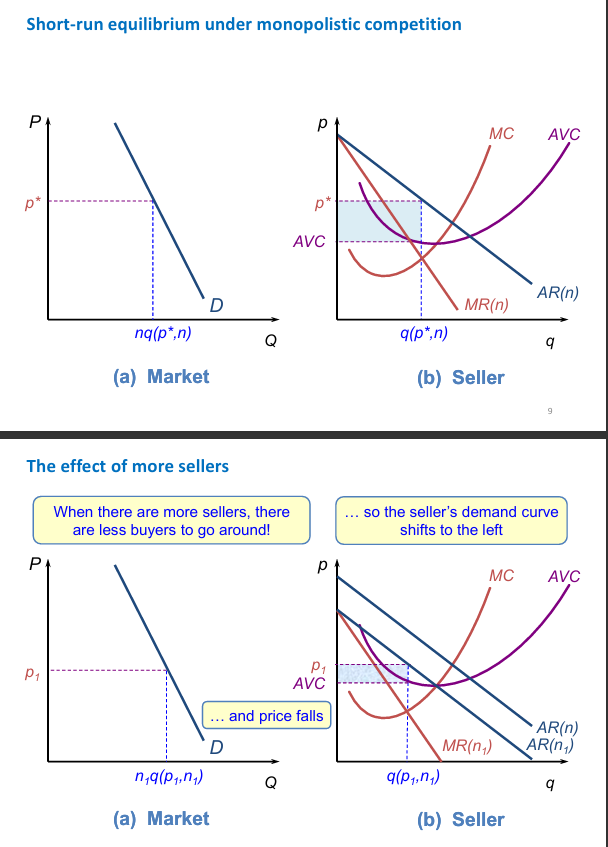
Short-run Equilibrium for Monopolistic Competition
R EQ is just price maker
AVC on y axis is correlating to Q*
demand is down-sloping in the market with EQ
more sellers —> less buyers so EQ price falls, thus shifting along demand curve
demand curve shifts to the left (ARn1)
MR curve shifts to the left (MRn1)
New Q (p1n1) and price (p1)
This means price falls and AVC rises
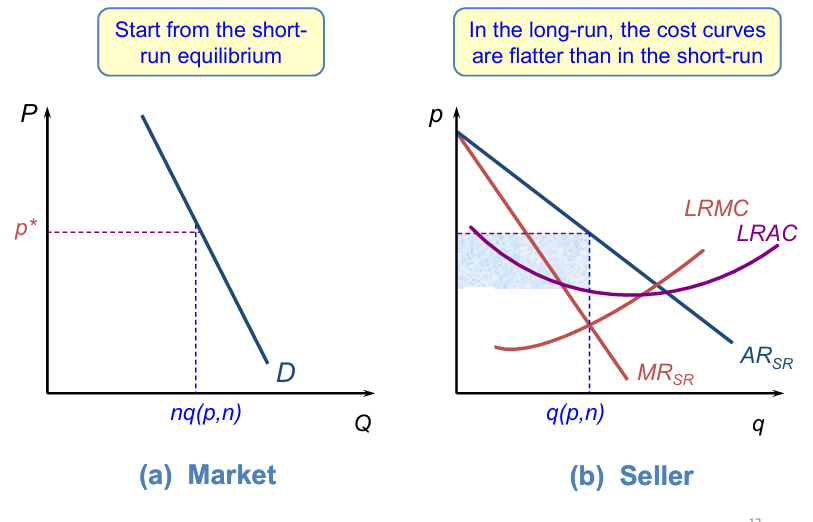
Long-run equilibrium of Monopolistic Competition:
All factors variable and other sellers can freely enter
Sellers make Normal profit in the LR
In the LR, cost curves are flatter
Firm is more efficient as costs fall
firms will enter the market until LR profit is zero
P (LR) = AR (LR) = LRAC
LR price = Where MR and MC in the LR intersect to meet the AR curve
Zero economic profit
PC vs MC vs Monop:
Feature | Perfect Competition | Monopolistic Competition | Monopoly |
|---|---|---|---|
1. Output rule | MR = MC | MR = MC | MR = MC |
2. Short-run profits? | Supernormal | Supernormal | Supernormal |
3. Price taker? | Yes | No | No |
4. Price | Equals MC | Above MC | Above MC |
5. Efficient output? | Yes | No | No |
6. Number of firms | Many | Many | One |
7. Entry in long run? | Yes | Yes | No |
8. Long-run profits? | Normal | Normal | Supernormal |
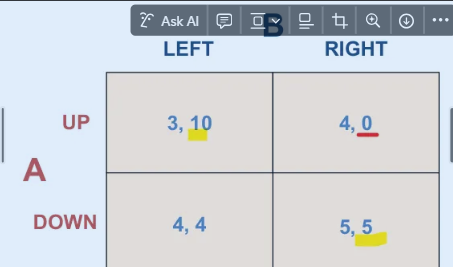
Dominant strategy:
The strategy that provides a player with the highest payoffs, regardless of an opponent’s strategy
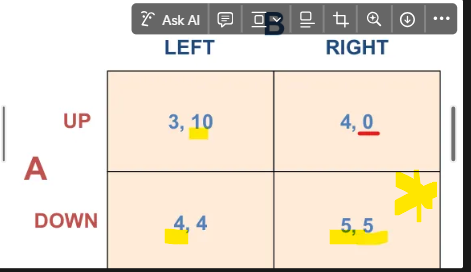
Nash Equilibrium:
There is no dominant strategy equilibrium
When no player can do better than their chosen strategy, given their beliefs of how the other players will play
Best response against opponent conjecture
Conjectures must be correct
Nash here is 5,5 (double underline)
Subgame perfect nash equilibria:
Subgame perfection is a refinement on the Nash equilibrium that allows us to make better predictions for sequential move games It requires there to be a Nash equilibrium in every “subgame”
Subgame perfect nash equilibria example:
A + UP —> B + Right (16,12)
A + Down —> B + Left (14,14)
A would go up
Nash Equilibrium is Up, Right
Correct conjectures
Assumptions of Oligopoly:
A1 Buyers are price takers + A2 complete information
A3 Sellers = Price makers ; downward sloping demand curve, as well as output choices triggering a reaction from its rivals
A4 Entry is BLOCKED; SR and LR
Cournot’s model of Oligopoly (specific assumptions):
A1 two sellers (duo-polists)
they choose the level of output to produce and make simultaneous decisions
A2 further entry is blocked to sustain the number of firms
A3 Homogenous products (for simplicity)
A4 the market’s inverse demand = P = a - Q
P = market’s inverse price
a = intercept of the inverse D curve
Q = total amount of output in the market
a > 0
e.g. if Firm A produces Qa + B produces Qb then Q = Qa + Qb
P = a - Qa - Qb
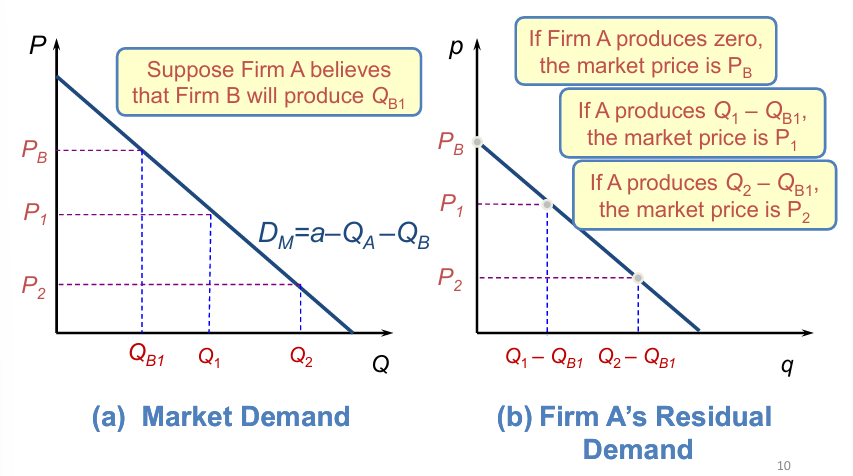
Firm A residual demand curve in Cournot’s Oligopoly Model:
the RDC = Firm’s demand curve, given the rival output (market demand that its rival has not supplied)
Firm A believes Firm B will produce QB1
A output = zero —> MP = Pb
A output = Q1-Qb1 —> MP = P1 (what is left by B is produced)
A output = Q2 - Qb1 —> MP = P2 (what is left by B is produced)
Match each point on Firm A’s diagram and connect to create the residual demand curve
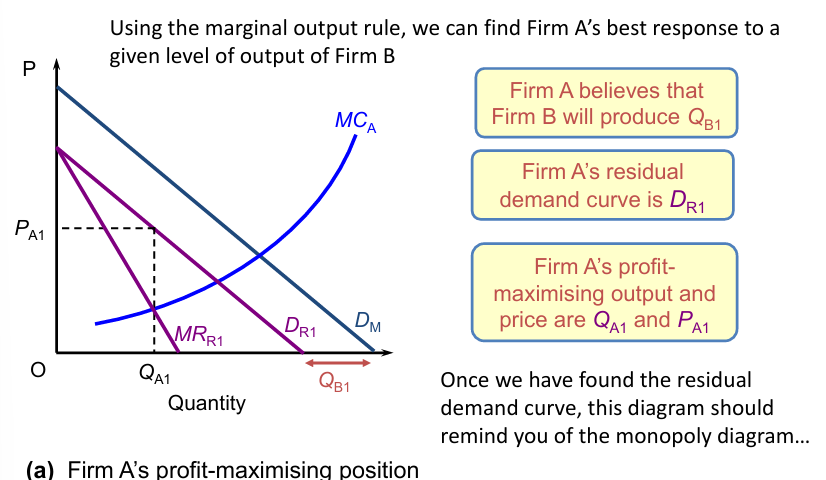
How to find Firm A’s best response, given Firm B’s output —> Pmax under Cournot’s Nash Equilibrium:
Assume B will produce Qb1 —> shift-in by QB1 (MD - rival output) —> DR1
Find MRr1 curve as usual
Cross over with MC for A ; MCa
price = PA1
Firm A believes what output B will produce
Establish residual curve
Shift curve by rival output
Determine P-max
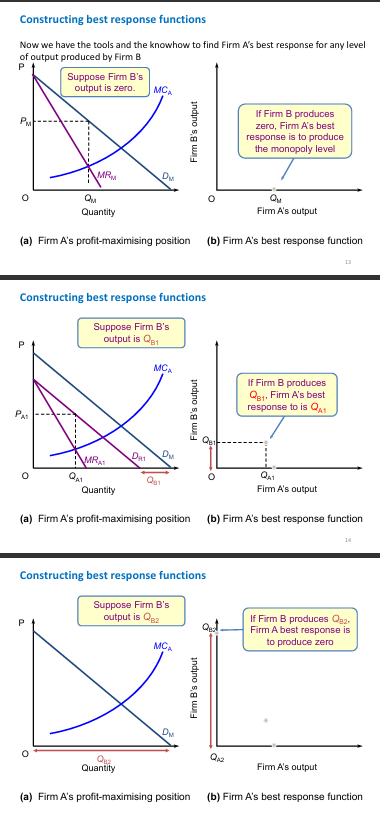
Constructing best response functions:
1:
Firm B output = zero, so there is no rival output
Best response = to produce at monopoly level
Qm (on output axis)
2:
Firm B output = QB1, so subtract QB1 from market demand Dm to find what’s left
best response = produce at Qa1, where MCa meets MRa1 (profit max)
Qa1 on output axis
3:
Firm B produces Qb2, complete rival output
best response = produce zero at Qa2
Qa2 on y-axis (where output is zero and price is high); same point where Dm meets y-axis
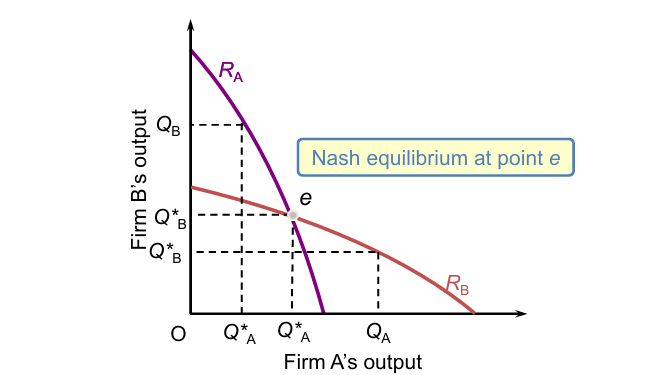
Cournot’s Nash Equilibrium diagram:
Nash equilibrium consists of two output levels,
Given that Firm B produces Q*b, Firm’s A profit is maximised by producing Qa
Given that Firm A produces Q*a, Firm B’s profit is maximised by producing Qb
To solve for the Nash equilibrium, we must find the firms’ best responses!
Ra = Firm A’s best response —> Pmax
Rb = Firm B’s best response —> Pmax
A duopolist’s output level is determined by the marginal output rule
We need to find each duopolist’s MR curve from their D curve
Comparisons of Cournot Oligopoly to Monopoly and Perfect Competition
Perfect competition, MCA and MRM
Monopoly still has higher price
Bertrand’s model of Oligopoly Assumptions:
two firms, duopolists, simultaneous price-setters
entry is blocked
Firms have the same constant MC, c, and no fixed costs
increasing MC is upward curve, whilst constant is where MC = AC
Homogenous products, not differentiated
buyers purchase cheaper good
Market demand is: Q = a - P
Q = TD when lowest price is P, where a > 0
If Firm A sets Pa below Firm B’s price of Pb, Q = a - Pa If Firm A sets Pa above Firm B’s price of Pb, Q = a - Pb
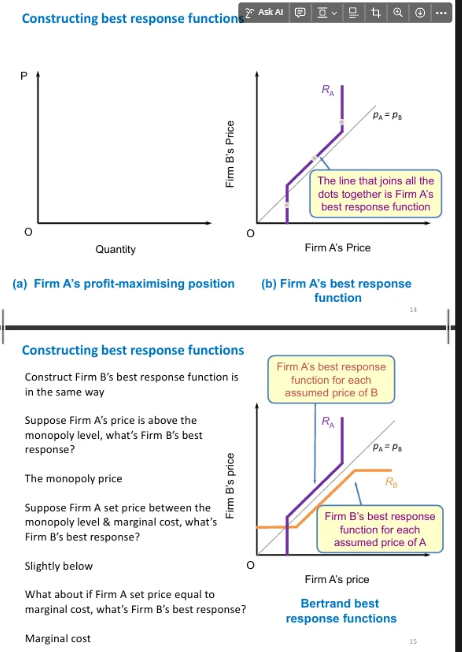
How to construct Bertrand best response function:
Set first point where P1 = Q1 as Firm A believes Firm B will set the same price
Find the residual demand curve which is DR, according to Firm A’s demand
Find points of Pmax which are Qa1 and Pa1, where MR crosses MC and complete
To create best response function, draw corresponding price diagram using 45 degree line (as both are simultaneous) and correlate Pm (from step 2) and the believed B price at b1
New scenario - Firm B price is below, same thing correlate Pb2
Correlate dots on Firm A best response function
Draw the inverse for Firm B on the best response function diagram
Thus this is the Bertrand-Nash EQ; where the two firm’s best responses intersect
Comparing Bertrand Nash EQ with Monopoly and PC in terms of price and welfare:
Duopolists set a lower price than the monopoly
Duopolists set the same price as the MP of PC and there is no DWL, maximised welfare
Bertrand Paradox and its 4 solutions:
Bertrand Paradox
Suppose there is one firm (monopolist) —> high P
One firm enters and sells identically, setting price under PC
We go from Extreme of Monopoly —> Extreme of PC???
Solutions:
Product differentiation
sellers don’t lose all of their customers when prices are higher
Capacity constraints
controls residual demand if control supply
Incomplete information
lower prices cannot attract if those are unaware
Repeated interaction
less intense competition
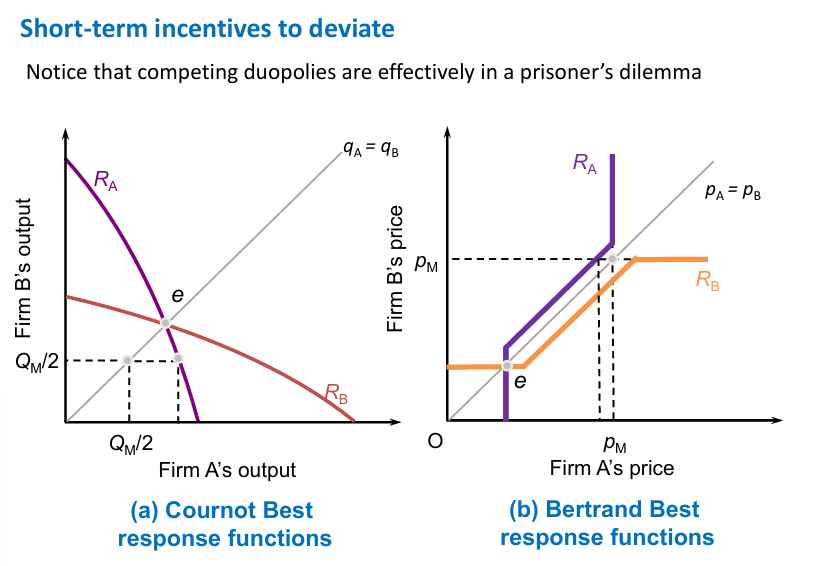
Bertrand and Cournot Pure Strategy Nash Equilibrium, and similarity to the Prisoner’s Dilemma:
Betrand - Pure Strategy Nash Equilibrium:
Equilibrium E where Firm A price = Firm B price
Collusion:
Both firms could collude and set higher prices where Pm= PM
This goes from HB VA —> VB HZ
Incentive to deviate
e.g. firm could increase onto its best response function —> Pmax (purple) and vice versa
Cournot - Pure Strategy Nash Equilibrium
Equilibrium E where Firm A price = Firm B price
Collusion:
both firms could restrict output (half) where Qm/2 = Qm/2, they share Monopoly profits and both are in equal positions
Incentive to deviate
e.g. firm could pr
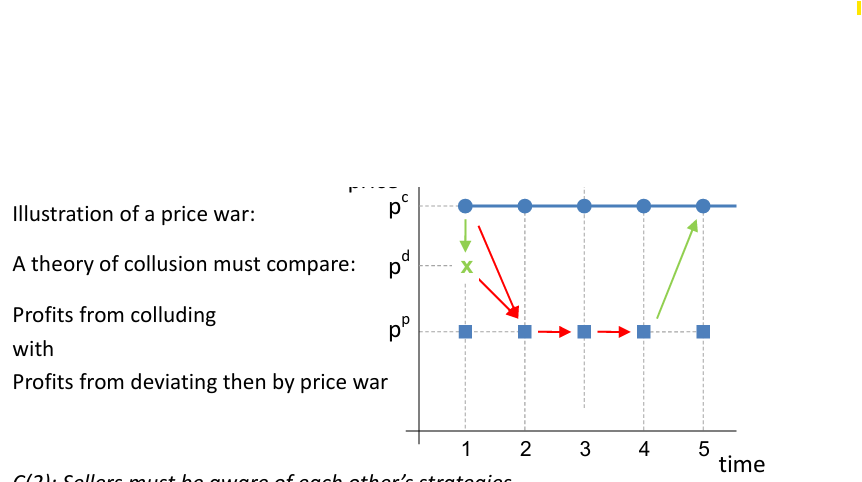
Conditions necessary for Oligopolists to collude:
Sellers must interact repeatedly
Incentive to deviate must be counteracted by a credible L-T punishment, usually a price war (period of low prices)
Sellers must have complete information of each other’s strategies
if they are not aware, then a price war cannot be threatened
Infinite Prisoner’s Dilemma:
The one-shot Nash Equilibrium (if played ONCE), is (deviate, deviate)
Both earn (75.75)
Cooperation —> 150,150 to benefit, but both would have an incentive to deviate to earn 200 instead of 150, at the expense of the other firm .
Is (cooperate, cooperate) a Nash Equilibrium of the repeated game?
Grim trigger strategy in collusion:
Each firm will cooperate, as long as the other has always done so
If a player deviates, both firms revert to playing the one-shot Nash equilibrium (deviate, deviate)
Punishment - price war forevermore.
Calculating present value of future payoffs:
Having £100 today =! £100 in the future:
in one period the future, assume r = 0.05 (IR), so £100 —> £105
Having £100 in one period’s time equivalent to today:
If £X is invested
X + (X x 0.05) = X (1 + 0.05) or X x 105%
X (1 + 0.05) = 100
X = 1 / 1.05 (100) = 95.24
£100 tomorrow is equal to δ(100) today where δ = 1 / (1+r)
Having £100 in two period’s time equivalent to today:
If £X is invested
X (1+0.05)^2 = 100
X = 1 / (1.05)^2 x 100 = 90.71
£100 day after tmrw = δ^2 (100) today, where δ = 1 / 1+r
Formula here: X = (1 / (1+r)^t )) x 100 = δ^t x 100
X = (1 / (1+r)^t )) x 100 = δ^t x 100
Expected presented discounted value of this stream of payoff =
X (δ + δ^2 + δ^n + …..) =~ X δ / (1-δ)
period 1 = X x δ = Xδ
period 2 = X x δ^2 = Xδ^2
period n = X x … = Xδ^n
Expected present discounted value of this stream of payoff =
X (δ + δ^2 + δ^n + …..) =~ X δ / (1-δ)
If you sub δ = 1 / (1+r), then Xδ / (1-δ) = X /r
Factors of production, units and cost to firm:
Labour: people available for employment —> output
Units: n. people, work hours
cost to firm: wage, salary
Variable in SR
LR - capital can replace it
Capital: machines and equipment used by labour to produce output
units: n. machines, tools, factories
cost to firm: rent, price
Land: site of production
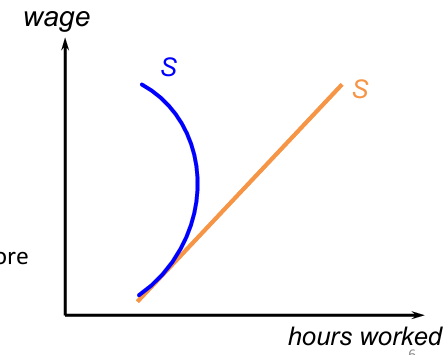
Supply of labour by an individual:
Two main costs: sacrificing leisure and unappealing work / high disutility
Substitution effect:
Higher wages —> more hours worked; greater OPPC of leisure
Income effect:
Higher wages —> afford more leisure time
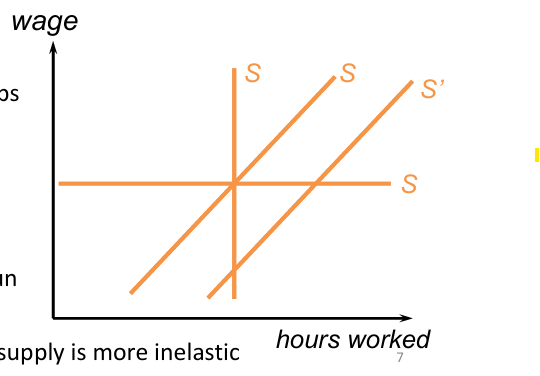
Supply of labour (to an employer and the market):
Employer wage taker —> perfectly elastic supply curve
Employer wage maker —> upward sloping supply curve
market labour supply curve
shifts caused by: # qualifications, NW benefits, cost of jobs (S’ —> S)
Responsiveness level to change in wages depends on:
difficulty to change jobs
LR or SR
Wages will rise more with demand if supply is more inelastic
Marginal Revenue Product of Labour (MRPL):
The change in TR revenue due to employing one more unit of labour
Marginal Cost of Labour (MCL):
MCL is the change in TC due to employing one more unit of labour
Relation between marginal input rule and marginal output rule:
(1) Marginal input rule: so long as the firm does not shut down, a buyer should employ the number of units of labour where
<aside> 💡
*marginal revenue product of labour) MRPL = MCL (marginal cost of labour)
</aside>
MRPL: The change in TR due to +1 unit of labour
MCL: The change in TC due to +1 unit of labour
MRPL > MCL —> +1 unit —> TR increase > TC increase
(2) Relation to the Marginal output rule:
<aside> 💡
MRPL = MR x MPPL (MR x Marginal physical product of labour)
</aside>
MRPL = MPPL x MR = MC
MR = MCL / MPPL = cost of extra UoL / n. units it produces (extra cost of producing one of those units of output)
Therefore, Marginal input rule and Marginal output rule are effectively the same
Assumptions for perfectly competitive labour markets:
A1 Buyers of labour (firms) operate in a perfectly competitive output market
Can sell as much as they want at current price without affecting price, p = MR
MRPL = MR x MPPL = p x MPPL
A2 Buyers of labour are wage takers in the labour (input) market
Can employ as much as they want at current wage rate without affecting wage rate, MCL = w
A3 Complete information
Workers are aware of available jobs and their conditions
Employers know quantity of available labour and productivity level
A4 Workers are wage takers
Cannot influence market price
Can supply as much labour at a given wage
Choice —> NO reaction from other workers
A5 Free entry for workers
No incurring costs, movement restrictions, no union barriers
Takes time and entry = LR
Characteristics of perfectly competitive labour markets:
Many small sellers (workers)
Low barriers to entry
Undifferentiated seller substitutability
Many small buyers (firms)
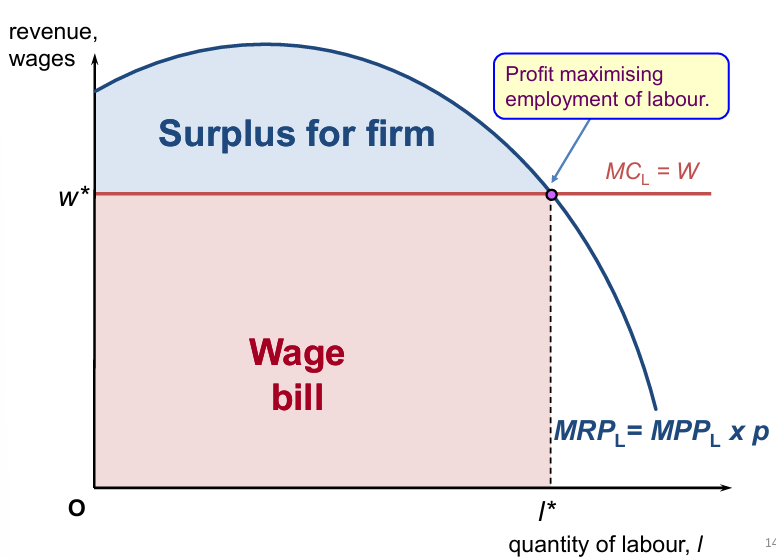
Pmax position for an individual firm in the labour market:
same curve shape as MPPL curve
Pmax = I* and W* intersected
Surplus is where quantity is above wage bill; any quantity before I* > wage bill, so below Pmax
if output price falls; MRPL1 shifts down to MRPL
I1 shifts left to I2,
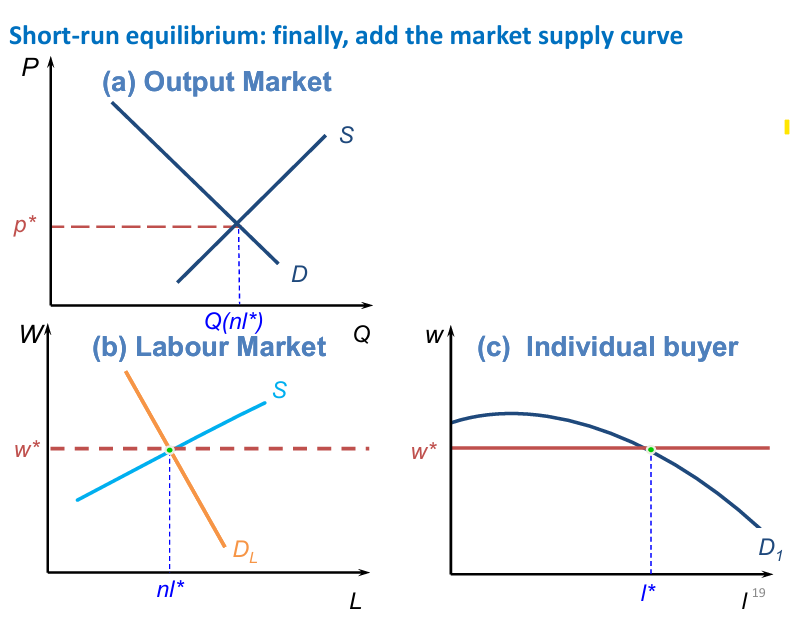
SR EQ in the Labour Market:
Buyers choose optimal employment levels
Sellers choose optimal supply levels
Sellers supply as much as buyers want to purchase
Product market price is determined by S&D
Market wage is determined by market S&D
Seller’s output is determined seller-specific S&D
Monopsony assumptions:
Assumptions
Perfectly competitive
Complete information
Workers = wage takers
Free entry
A2 - the firm is a wage maker in the labour market; can influence the wage at which it employs labour
Monopsony market characteristics:
undifferentiated workers
complete information
Workers are equally productive and buyers and sellers are fully informed
Many small sellers (workers)
One large buyer (firm)
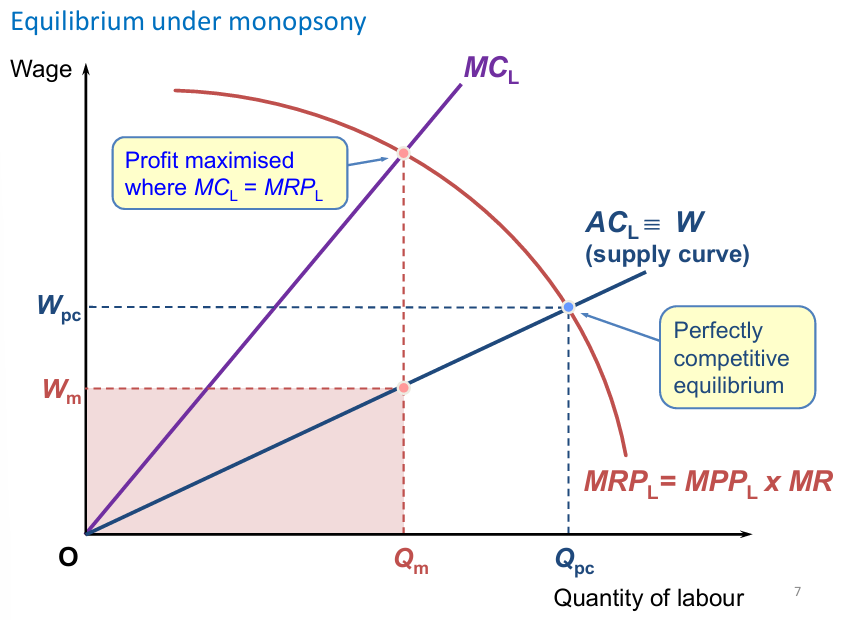
Equilibrium under Monopsony and diagrammatic analysis:
+1 unit:
another unit is employed at wage w, TCL increase w
all other units are employed at a slightly higher wage, so TCL increase by sL
L represents the units employer at the lower wage
S represents how much the wage has risen (Supply curve slope)
Supply curve = s = W = ACL (as established)
MCL = left of the SC as MCL > ACL
MRPL = MPPL x MR (as established) - how much TR rises if +1 unit employed
Pmax is where MCL = MRPL at Qm
Qm = how much labour the Monopsony should employ
Wm = wage rate at which the Monopsony should employ
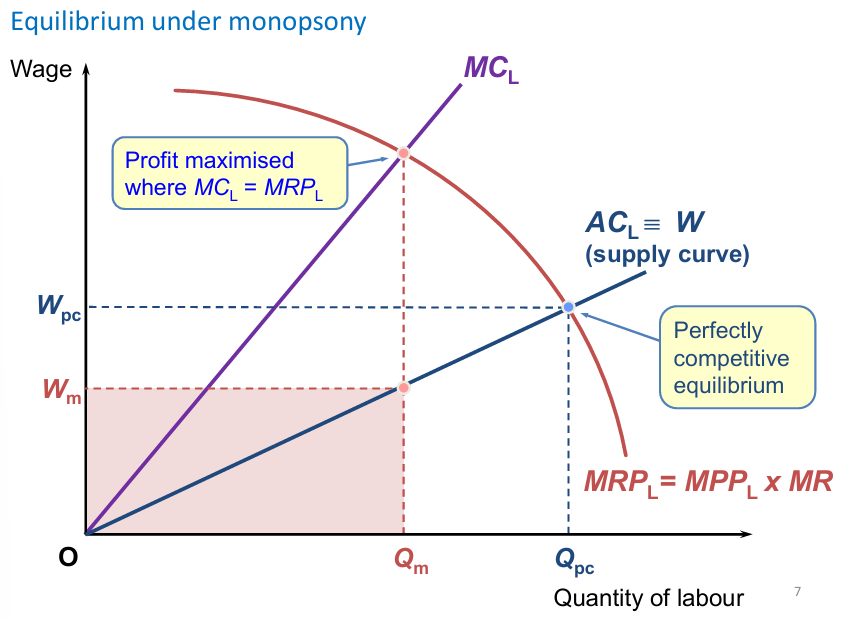
Comparing Equilibrium under Monopsony and Perfect Competition:
COMPARISON: Perfectly Competitive EQ is where Qpc = Wpc on ACL curve
Q is higher and W is higher at pc, but there is now only one firm and thus a wage maker and can employ more workers are lower wages.
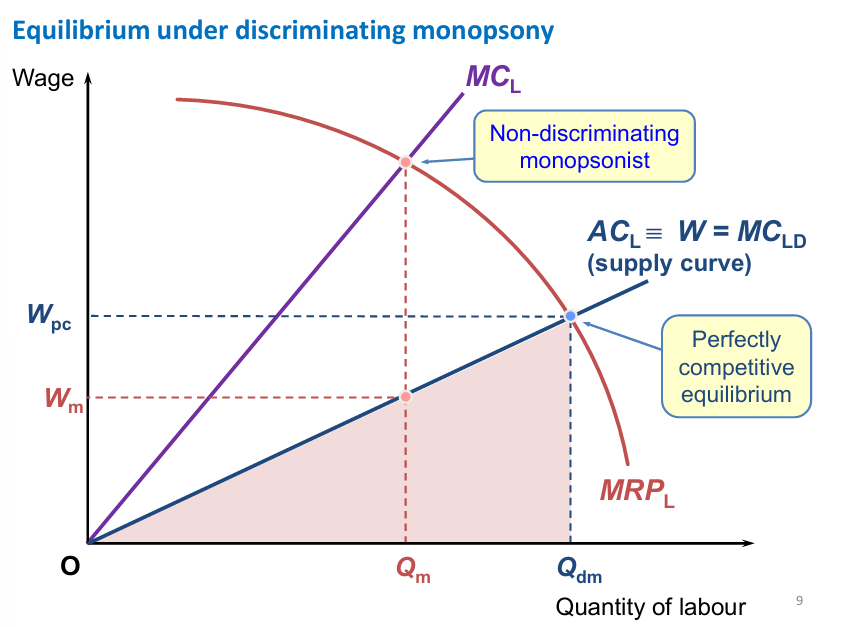
Discriminating Monopsony:
there are Lpc units of labour employed
This is determined by the intersection of MCLD and MRPL
Same units of labour employed as under perfect labour markets but wage bill is lower, so the surplus for the firm is larger
There is no deadweight loss
at Qdm, wage rate is higher compared to non-discriminating
Monopoly Union Assumptions:
Perfectly competitive output market
Complete information
Firms = wage takers
Free entry
Workers are wage makers; each worker is a member of a union, facing no outside competition
common interest of maximising insider wages and employment
Assume the union sets a minimum wage
Evaluation of Monopoly Union:
Benefits those in employment
Benefit’s their members by increasing wages
Higher wages —> lower total employment
Harms those who became unemployed and those who purchase output as price = higher
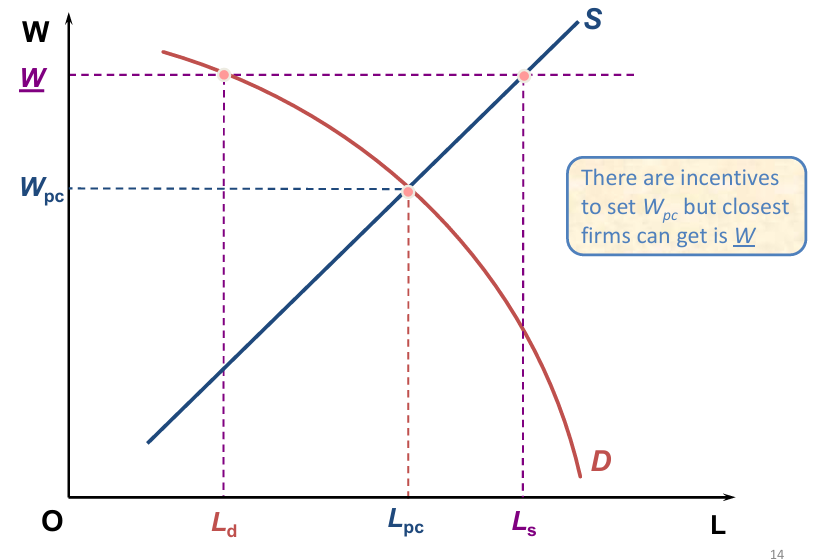
Monopoly Union and diagrammatic analysis:
Increased wages —> higher TC and exit —> lower EMP and Higher prices
shift from S to S’ at lower Q and higher Price
No union: wage determined by intersection between Wpc and Lpc
With union: Minimum wage —> perfectly elastic supply curve at W
at W (above Wpc)< employment falls from Lpc to Ld
Unemployment = Ls-Ld
Ls = units of labour want to be employed at MWR
Ld = units actually employed
Benefits those in employment
Harms those who became unemployed and those who purchase output as price = higher
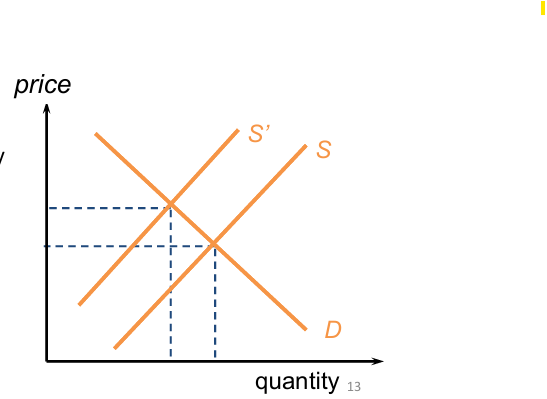
Bilateral Monopoly assumptions
perfectly competitive output market
Complete information
Free entry
Firm = wage maker
Workers = wage maker
both can influence wages
Bilateral Monopoly characteristics:
undifferentiated workers
complete information
One large worker (union)
One large buyer (large change)
Efficiency and equity in markets:
Efficiency:
in what ways are the allocation of resources socially desirable
efficiency and equity
efficiency: size of the pie, big as possible
Equity: how the pie is divided
when will the allocation of resources be socially desirable and when not?
if not socially desirable, what is the best policy to resolve the problem?
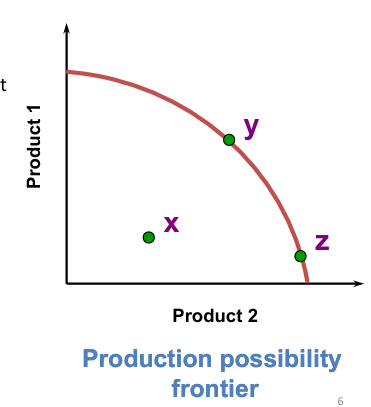
Productive efficiency:
Allocation of resources within a firm; production at lowest possible cost
Allocation of resources among firms; TQ at lowest cost
MC = MR
Allocative efficiency:
Optimally distributing resources to maximise consumer satisfaction
No gain should be made by reallocation; gains are maximised
P = MC
Type of firms and if they are allocative or productively efficient (list them):
Type of Firm | Allocative Efficiency (P = MC)? | Productive Efficiency (Min AC = MC)? |
Monopoly | ✅ Yes (in the long run) | ✅ Yes (in the long run) |
Perfect Competition | ❌ No | ❌ No |
Monopolistic Competition | ❌ No | ❌ No |
Oligopoly | ❌ No | ❌ No (unless behaving like perfect competition) |
Natural Monopoly | ❌ No | ✅ Yes (can exploit economies of scale) |
Monopsony | ❌ No (restricts input purchases) | ❌ No (may not operate at minimum AC) |

How can indifference curves being added to the Edgeworth box create Pareto improvements and optimal resource allocation (explain diagrams)
Bundle C > Bundle B as more is preferred to less
Bundle B > Bundle C are more is preferred to less and average is preferred to extremes
Person X utility increases with more water and berries as it requires more of both good, and more is preferred to less / average > extreme
Person X moves closer to origin Oy as it increases volume
Person Y utility increases with more water and berries as it requires more of both good, and more is preferred to less / average > extreme
Person Y moves closer to origin Ox as it increases volume
This brings X and Y closer to the Pareto optimal point
Pareto improvement is present as Person Y and X are better off without harming the other person ‘s utility
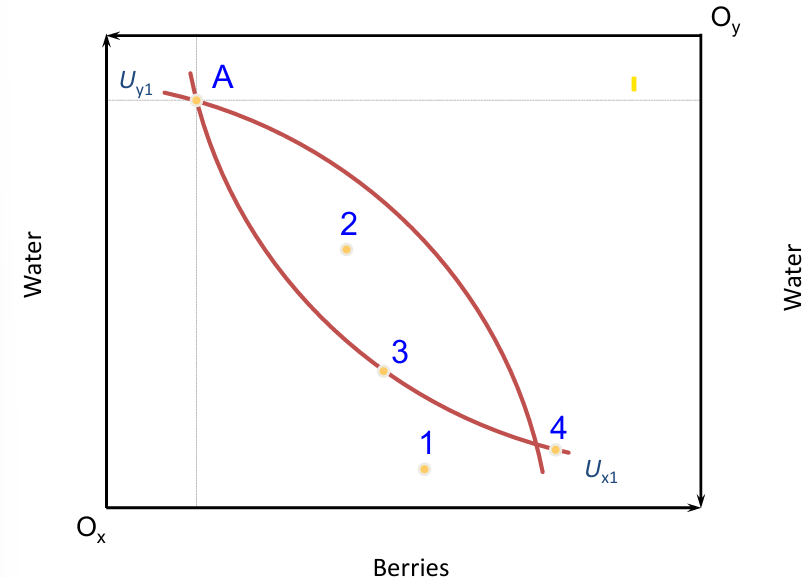
Pareto improvements:
Bundle 1 - Person X is better off as their utility increases as they move closer to their indifference curve Ux1 but Person Y is worse off as they exceed their optimal indifference curve Uy1 ☹
Bundle 2 - utility of Person X and Y both increases without crossing the alternative indifference curve, thus neither are worse off 🙂
Bundle 3 - utility of Person X and Y both increases without crossing the alternative indifference curve, thus neither are worse off (person Y reaches X indifference curve but does not cross it) 🙂
Bundle 4 - Person Y is worse off as this bundle lies to the right of their indifference curve ☹
Characteristics and types of externality:
Positive: External benefit to a third party
not enough produced in a market
positive production e.g. new airports and technological research
positive consumption e.g. education and immunisations
Negative: External cost on a third party
too much produced in a market
negative production e.g. air and water pollution
negative consumption e.g. loud music and cigarette smoking
Production and consumption externality
Banning all products with negative externalities is not socially desirable e.g. ban all cigarettes
amount with best trade off is recommended
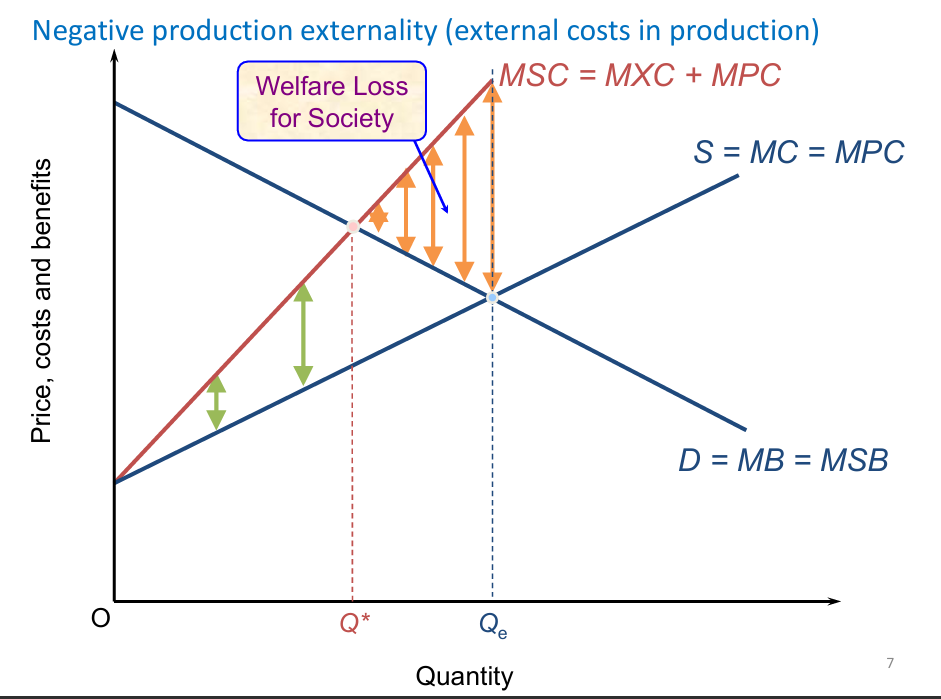
Negative production externality diagram:
Qe is where marginal social benefit = marginal benefit and marginal private cost = marginal cost (demand and supply) meet
Demand = benefit as consumers benefit from output
supply = cost as firms have to pay for production and is thus a cost
There is a welfare loss for society above the demand curve and is greater at higher quantities above Q*
Q* is the optimal equilibrium where quantity is lower and prices, C&B are higher; this means less external costs of production, bringing society closer to the socially optimum equilibrium
Welfare loss decreases as you move closer to the SOE
Negative production externalities cannot be zero as it is not optimal, but should be at a lower desired Q
Therefore, Qe —> Q*, quantity falls and price increases, so NEX decreases
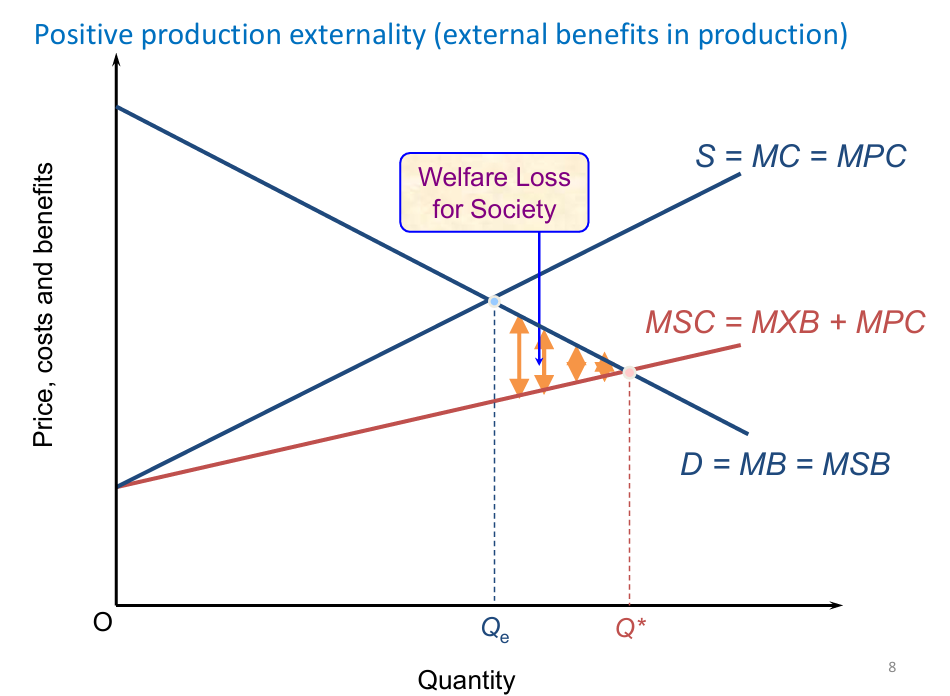
Positive production externality diagram:
Qe is where marginal social benefit = marginal benefit and marginal private cost = marginal cost (demand and supply) meet
Demand = benefit as consumers benefit from output
supply = cost as firms have to pay for production and is thus a cost
There is a welfare loss for society below the demand curve and is greater at lower quantities above Q*
Q* is the optimal equilibrium where quantity is higher and price are lower; this means more external benefits in production, bringing society closer to the socially optimum equilibrium
Welfare loss decreases as you move closer to the SOE
Positive production externalities cannot be very high as it is not optimal, but should be at a lower desired Q
Therefore, Qe —> Q*, quantity rises and price decreases, so PEX increases
Pigovian taxes and pollution:
e.g. pollution
Government can either
regulation: restrict waste to Y units of pollution per unit of output
Pigovian tax: each firm pays T per unit of output
reduces pollution, more efficient at pollution reduction, environmentally friendly, raises money for government
Social efficiency in terms of externalities:
social planners would intervene in socially inefficient markets
market based policies can be used e.g. per unit taxes and per unit subsidies
tax if production is too high (Pigovian tax)
subsidise if production is too low
thus internalising the externality and aligning private incentives with social efficiency
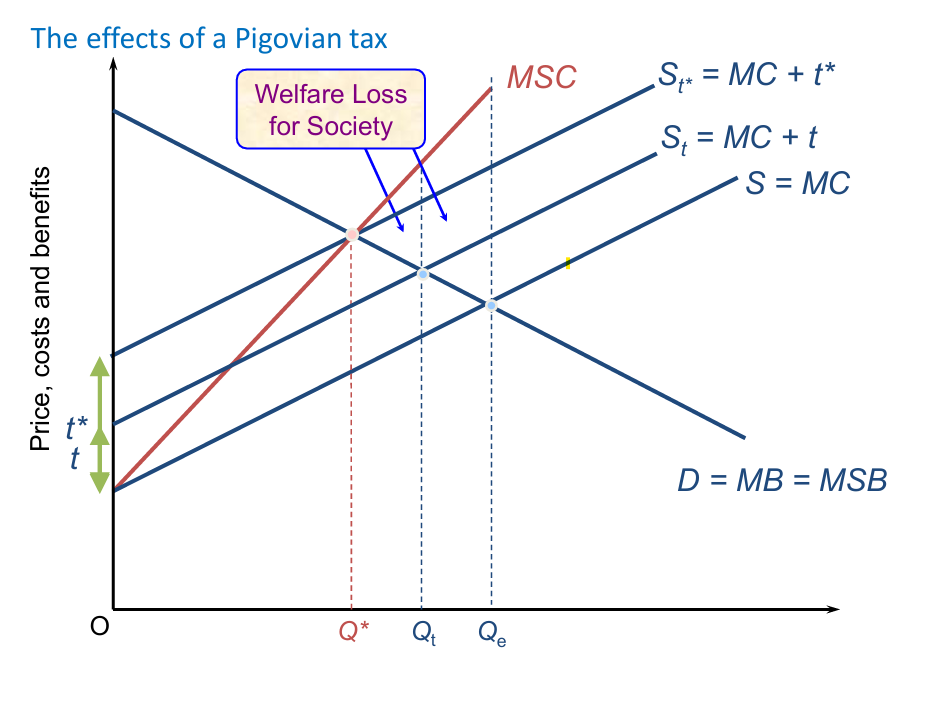
Effects of a Pigovian tax in a diagram:
Pigovian taxes increases prices from t to t* and restrict output from Qe to Qt
t* is a certain level of Pigovian tax but not the optimal (t), while output still does fall
Both are closer to Q* SOE
St* = MC + t* at Q* (which is the optimal tax level, any further taxes may cause tax evasion or market exit)
Welfare loss for society decreases as production of negative externalities falls and government tax revenue increase
Rival product and its types:
Rival Product: A product where one person's consumption reduces availability for others (e.g., food, clothing).
some can be consumed by only one person
some can be consumed by multiple but not simultaneous
some can be consumed by multiple but not by another person at the same time
Non-rival product:
Non-Rival Product: A product that multiple people can consume without reducing its availability (e.g., public parks, digital content).
Excludable products and its types:
Excludable: consumers can be excluded from the benefits of a product
products from which non-payers could be and are excluded e.g. private gym memberships
products from which non-payers could be and are NOT excluded
Non-excludable products:
consumers can be excluded from the benefits of a product .g. streetlights / national defence
Table of (non) rival and (non) excludable goods (give 2 examples of each combo):
Rival | Non-rival | |
Excludable | textbooks / loaf of bread / cinema tickets / congested motorways (Private goods) | tv channels / motorways like tolls or uncongested (club goods) |
Non-excludable | fish in the ocean (common resources) | Streetlights / firework displays / small roads (public goods) |
Theory and solution of Free-Rider problem:
The product is underproduced even though societal value > cost of providing it
e.g. fireworks display, which is under-provided
supplier choose to ignore external benefit (such as non0-buyers being provided external benefits)
Solution: gov pays for the display and recoups costs through taxation
Definition of Free-Rider:
Free Rider: a person who receives the benefit of a good but does not pay for it
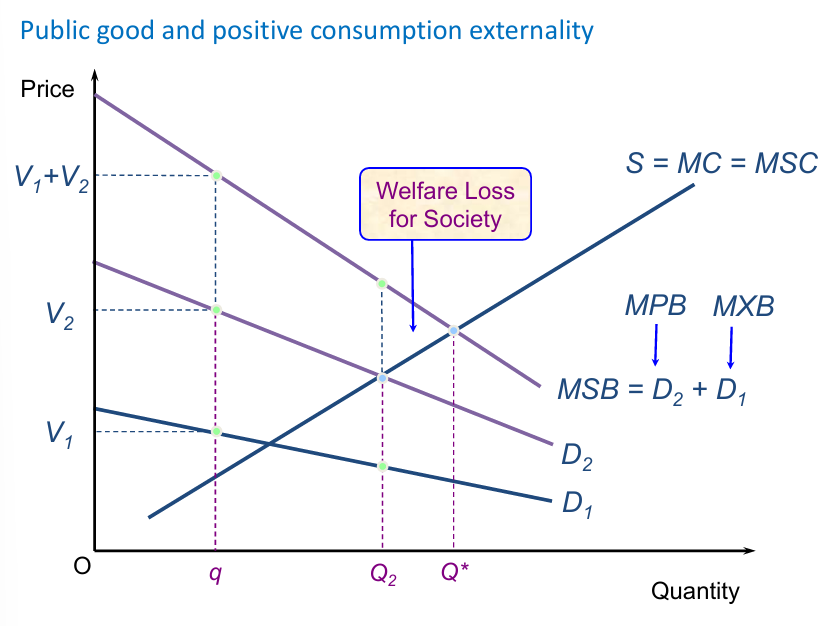
Free-rider problem as a diagram (explain):
q = quantity of fireworks
V1 = MPB for person 1 on their demand curve ; free-rider, so demand is lower at MXB (did not pay)
person 1 buys so Q is higher where Q2 meets D2 (compared to D1 Q1 for free rider)
V2 = MPB for person 2 on their demand curve ; assumed as MPB, greater benefit than D1
MSB = D2 + D1 (total private benefit)
Supply curve = MC and MSC (no externalities in production
Q* = optimal SOE
Welfare loss = diff between MSB and MSC for the units not provided, market provides level of Q2
Solution to the Tragedy of the Commons:
Solution: property rights and rules
Farmers who own land with legally protected property rights have an incentive to invest in better irrigation, fertilizers, and sustainable practices. Without secure property rights, they may fear land seizure and avoid long-term investments, leading to lower productivity and inefficient land use.
This allows farmers to protect and improve their own land, preventing env. degradation in which government / private bodies will regulate farmer activity
Promotes sustainability, sustains profits for farmers and reduces env. degradation
However, due to scale and private incentives, implementation and regulation is difficult
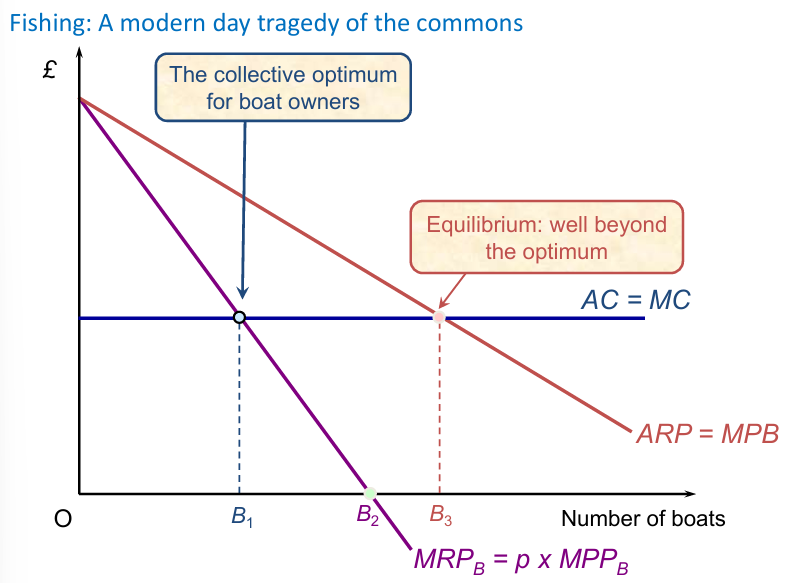
Explanation of the diagram for the Tragedy of the Commons (fishing)
AC = MC = MPC
ARP = AR per boat —> MPB
Equilibrium is beyond optimum at higher Q to increase revenue (B3)
This is where tragedy of the commons occur as B3 > B2
B1 is collective optimum to prevent significant env. degradation (SOE)
this is where MSB = MSC where B1 meets D curve
Solution: property rights and rules
Imperfect information:
Imperfect information:
Buyer lacks information about prices
Buyer’s behaviour determines level of information
Firms have market power
Asymmetric information:
One side lacks more information than the other side
Lack of information determines behaviour
High quality markets may not exist
Theory example of Imperfect information:
two firms sell an identical product; costs = c, consumers want to buy one unit, consumers value products at v < c, consumers know both prices and are willing to shop at either
Perfect : When Consumers have perfect info, they receive all benefits from trade
Imperfect: Consumers do not know the prices and finding info is costly
When Consumers are uniformed about prices and finding info is costly, they receive no trade benefits
The Unravelling Principle
The Unravelling Principle
Firms have incentives to provide info for the uniformed
Holds if:
Product differentiation is important to consumers
Costless, credible statements about products can be made by firms
Intuition —> no info —> all firms ‘average’; random selection
Firm offering best terms > average —> should disclose info to increase consumers
3 types of goods under Asymmetric information:
Search goods: easy to assess quality pre-purchase 🙂
Experience goods: difficult to assess quality pre-purchase :]
Credence goods: difficult to assess quality pre and post purchase 😟
The Problem of Adverse Selection
To buy the cars, it costs the firm : £3000 for a high quality car / £100 for a low quality car
Consumers are willing to pay: £4000 for a high quality car / £1000 for a low quality car
Firms could make: £1000 from selling a high quality car / £900 from selling a low quality car
consumers cannot tell the diff in quality (experience goods)
Average willingness to pay = (4000+1000) / 2 = 2500
Uninformed consumer choosing at random is willing to pay £2500
Salesperson would make a loss of £500 if they sell high quality car at what consumers are willing to pay —> only low-quality cars will be bought and sold
market for high quality cars affected —> adverse selection affected by asymmetric information
3 Solutions to Informational Problems in a market:
Types | Example |
Signalling | high quality claim credible such as fixing cars for free if they break down |
Screening | buyers get information on firm’s reputation e.g. reviews, TripAdvisor |
Government intervention | minimum standards, verifying firm’s claims, providing information or publicising it |